Collaborative projects
Collaborative projects between UoN and BGS related to biogeochemical cycling.
Assessing human impacts on the Red River system, Vietnam, to enable sustainable management
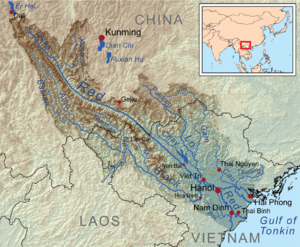
The Red River in Vietnam is located in a rapidly developing area of the world's 13th most populous country. The area, which supports 20 million inhabitants, includes a major rice-growing region, the mega–city of Hanoi and a range of industries each of which have expanded in recent decades. The Red River Delta (RRD) delta area of the river which discharges water into the Bay of Tonkin provides crucial ecosystem services including the retention and removal of nutrients and pollutants for groundwater (drinking water) and marine resource protection, carbon processing, flood protection which is heavily managed through a series of agricultural dikes and sediment transport which governs erosion and deposition at the vulnerable coastal zones. However, hydropower dam installation, increasing agricultural fertilizer use, increases in urban wastewater and use of a range of toxic contaminants threaten these ecosystem services and the health and wellbeing of the people who live in this region. The delta region is a complex and highly modified hydrological network which is difficult to model using calibrations developed on more straightforward river basins from temperate regions. The project (funded through a RCUK Newton–SEA Research Partnership Call) focuses on filling in knowledge gaps in understanding on relationships between hydrology, nutrients, carbon and pollutants in the RRD region for improved model calibration using a combination of stable isotope and organic geochemistry techniques which have rarely been applied in this area. The project is headed by Prof Suzanne McGowan (UoN) with collaborators: Dr Anh Duc Trinh, Dr Do Thu Nga, Dr Thi Nguyet Minh Luu, Dr Thi Phuong Quynh LE (Vietnam Academy of Science & Technology), Dr Virginia Panizzo (UoN), Dr C Vane (BGS), Professor Melanie Leng (UoN/BGS) and Dr Minh Tien Tran (Vietnam Academy of Agricultural Sciences).
Are land–use decisions of African elephants based on environmental geochemistry?
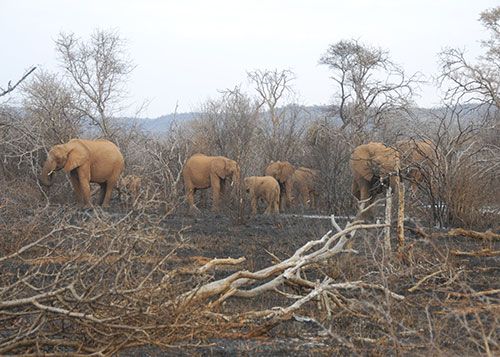
This project will explore the role of environmental geochemistry in land use decisions by wild African elephants. This is a unique, interdisciplinary project involving environmental geochemistry, plant science, and animal health between a range of partners, including BGS and UoN to address research questions which have important and practical implications for wildlife health and conservation. In the first phase of the project, mineral levels in a range of biological samples (serum, hair, nails) from elephants at five UK zoos will be measured to validate their use as possible biomarkers of mineral status in wild elephants. The mineral content of food, soil and water consumed by these elephants will be determined, with training in advanced inductively coupled mass spectrometry (ICP–MS) and stable isotope techniques. The second phase of this project will apply these validated methods to a study of wild African elephants. The multi–element capability of ICP–MS for measuring environmental/biomonitoring samples enables an estimation of mineral balance and potential metal uptake. The working hypothesis is that the elephants in this study group are deficient in phosphorus, owing to a deficiency in the (soil and) forage in a South African National Park. This drives the elephants to supplement their phosphorus from the water, soil and forage on land surrounding a phosphate mine in close proximity to the National Park. Elephant incursion into nearby human settlements has resulted in human–elephant conflict, causing risk of injury and lost income. This project may identify key locations in the elephants’ home range where mineral–supplemented forage, or mineral licks, may be placed to reduce the drive to seek additional sources of phosphorus; this could reduce human–elephant conflict.This project provides opportunities for varied work: fieldwork in UK Zoos and South Africa for environmental/biomonitoring analyses of wild elephants, specialist laboratory and data interpretation training at BGS and UoN and translation into advice to relevant...
Biogeochemical Cycling of Heavy Metals in Soil
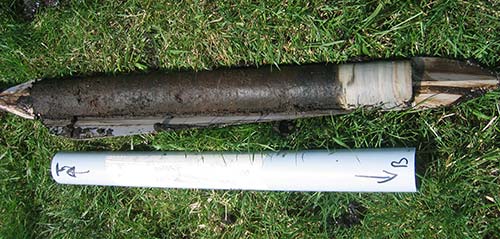
Understanding biogeochemical cycling of heavy metals in soils depends heavily on being able to accurately measure and model transfer from the solid soil phase to plants and microbes via pore waters, as this is the pathway that they derive nutrition or are exposed to toxic concentrations. Drs Simon Chenery and Andy Tye (BGS) have been collaborating with Drs Scott Young and Liz Bailey and several PhD students (UoN) for many years and have shown that the use of specialised isotope exchange methods provide a mechanistically robust estimate of the pool of reactive metals e.g. lead, cadmium, zinc, nickel and copper. Initial method development for Pb was undertaken by Dr Nicola Atkinson UoN/BGS (Atkinson 2010s). The technique was subsequently applied to a small contaminated catchment with highly variable geology in NE England (Marzouk et al. 2013). Further work focused on how more common soil extraction methods may be employed which will allow a higher throughput to investigate soils and their toxicity from across the UK (PhD student Judith Garforth and Dr Steve Lofts, CEH Lancaster) and extending methods to remediation of uranium contaminated soil and water (PhD student Ahmed Ashry). Recently, the fate of ZnS nanoparticles (produced during sewage treatment processes) in soils has been examined (PhD student Beckie Draper).
Soil geochemistry to inform agricultural and health policies
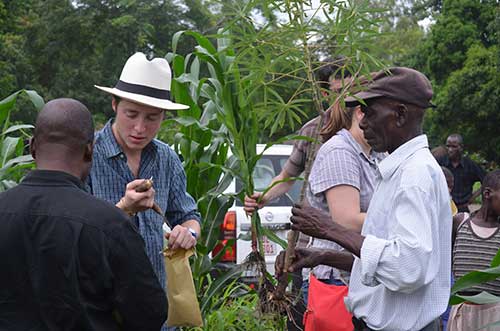
Dietary micronutrient deficiencies are a major health burden globally. Understanding the influence of soil geochemistry on food production and nutritional security is an essential component of policy support for agriculture (e.g. liming or fertiliser rates) and public health (e.g. identifying regions at risk of micronutrient (MN) deficiencies and toxicities) particularly in a subsistence farming context. At present, the capacity to capture and integrate soil geochemical data across multiple scales has not been achieved in Sub-Saharan Africa (SSA), especially in analytical research capacity.
Since 2009, BGS (Dr Michael Watts and Dr Louise Ander) have worked with the UoN (Prof Martin Broadley, Dr Scott Young, Dr Liz Bailey), Lilongwe University of Agriculture and Natural Resources and the Malawi Government Ministries of Agriculture and Health to characterise the risk of MN deficiencies in Malawi and investigate mitigating strategies through soil geochemical controls for soil-plant transfer. This work has largely been achieved through joint PhD projects and BGS, UoN, DFID and Malawian government support. This has recently broadened to include similar university-research partnerships in Malawi, Zambia and Zimbabwe, focussing on specific aspects of soil-to-plant MN transfer and have complementary themes in analytical chemistry, geospatial sampling and soil management.
Specific projects include geospatial variation of MNs from Malawi soils. It was established that dietary selenium (Se) intakes are likely to be deficient on low-pH soils because of low availability of Se for plant uptake (Chilimba et al. 2011). This was confirmed through direct analyses of diet composites and blood and urine samples, with median intakes of 6.5 μg d-1 for adult women living on low-pH soils, compared to 55.3 μg d-1 for women living on calcareous soils in the Shire Valley region and an estimated average requirement of 45 μg (Hurst et al. 2013). Since the majority of soils in Malawi are low-pH, dietary Se deficiency is likely to be widespread with potential consequences for cardiovascular disease, efficacy of anti-retroviral medication and other health outcomes. Biofortification of maize using Se-enriched fertilisers could be a cost-effective intervention (Chilimba et al. 2012). The team are now working to further investigate the influence of soil type on diet composition and deficiency estimates for multiple minerals including calcium, iron, iodine and zinc (Siyame et al. 2014, Joy et al. 2013, Joy 2013; Joy et al. in press).
Other collaborations include:
- design of database architecture to collate environmental and health metadata. Commenced in 2013 with the Malawian Department of Surveys to establish database protocol for the Ministries of Agriculture and Health to collate disparate data to inform policy e.g. using statistics, spatial analyses (NERC, World Bank in progress).
- Characterisation of biogeochemical controls on MNs and metal (contaminant) bioavailability from African and European agricultural soils. Joint PhD projects to commence 2014.
- A joint PhD started in 2013 on micronutrient deficiencies in South East Asia: geospatial variation and modelling of nutrient soil-plant transfer.
Channel wetted width for improved prediction of carbon dioxide evasion from streams
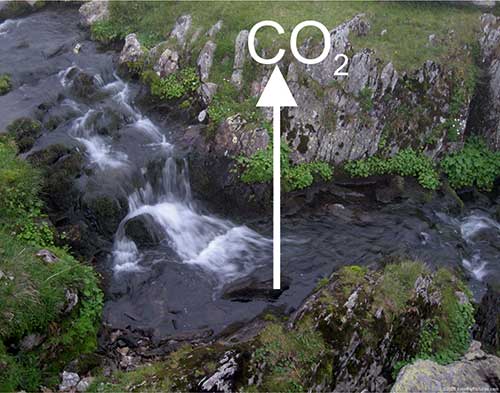
Research is underway between Mr Liam Clark (MSc student), Dr Barry Rawlins (BGS) and Dr Doreen Boyd (UoN) on factors controlling the wetted widths of stream channels using a unique set of national air photo data (Rawlins et al. 2013). This work has so far demonstrated that there is a link between the hydrology/hydrogeology of catchments and channel width through an interaction with catchment area and links to another recent BGS study on carbon dioxide evasion at national scale across England and Wales soon to be published in the journal Biogeosciences. It is necessary to know the width (surface area) of stream channels to accurately estimate the quantity of carbon dioxide which evades from them to the atmosphere. This is thought to account for around 10 per cent of the global flux of carbon from the terrestrial biosphere to the atmosphere. This study has led to a PhD project being undertaken by Liam Clark in the School of Geography, UoN.
Normal Background Concentrations in soils of England and Wales
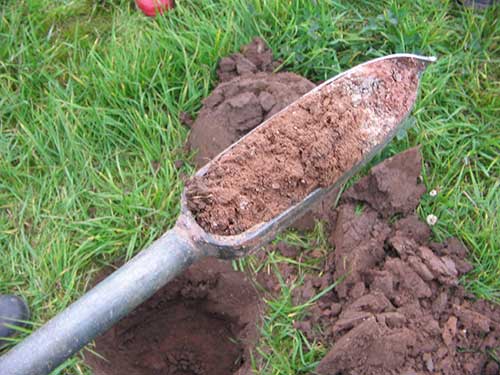
Research has been recently been undertaken by Dr Louise Ander (BGS), Prof Paul Nathanail (UoN) and others at BGS on establishing Normal Background Concentrations (NBC) of selected contaminants in soils of England and Wales. This study was undertaken for Defra in support of the revision of the Part 2A Contaminated Land Statutory Guidance. The outputs were twofold: (1) an open-source methodology for calculating NBCs; and, (2) domain specific NBCs for arsenic, cadmium, copper, lead, mercury, nickel and benzo[a]pyrene. Project reports are available. These additional materials include: a bibliography of references used; metadata on datasets which were used; an interactive viewer of geochemical images for the inorganic contaminants; R-scripts (for calculation of NBCs); and, our open-access publication Methodology for the determination of normal background concentrations of contaminants in English soils published in Science of the Total Environment. The work has made an important contribution to the evaluation of risks to human health under Part 2A. It has been followed up by a Local Authority contaminated land officer who developed NBC for lead for her area as part of her dissertation for the Nottingham Masters in contaminated land management.
